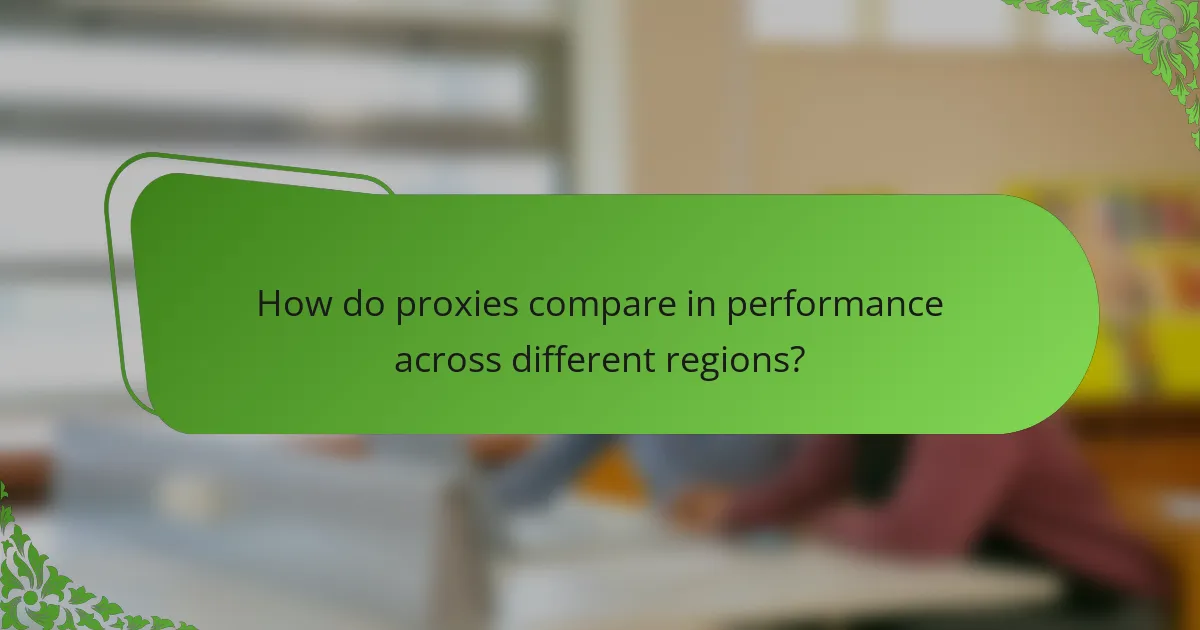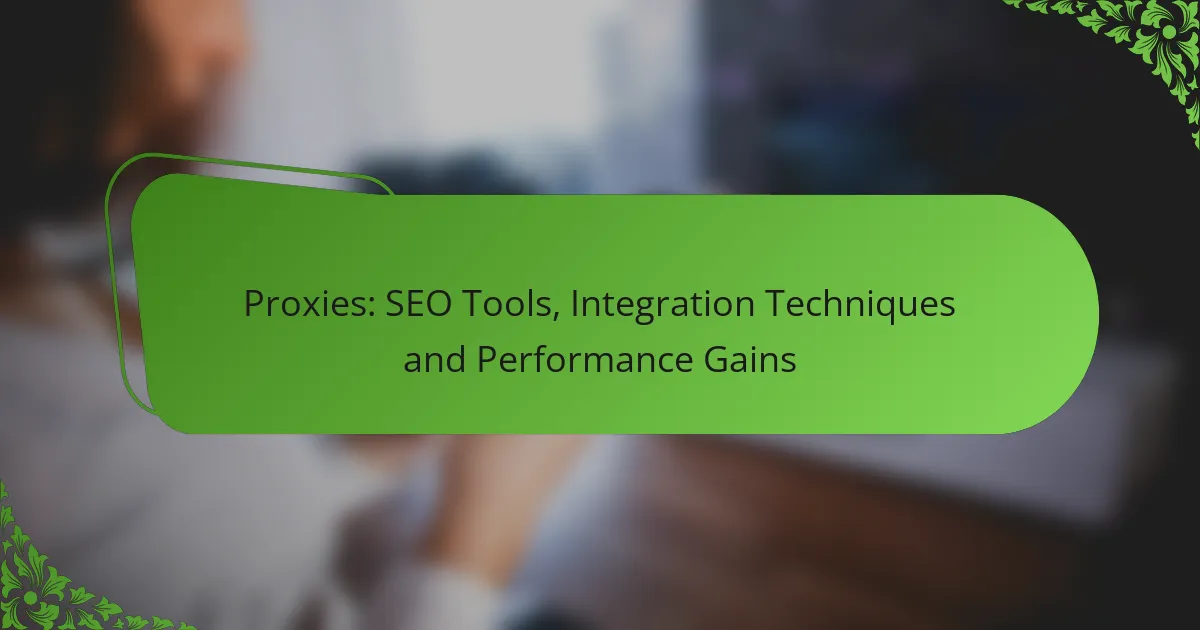Proxies play a crucial role in optimizing SEO tools by providing reliable and diverse IP addresses that enhance web scraping and data collection. They not only improve performance by reducing the risk of IP bans but also facilitate geo-targeting, allowing businesses to gather valuable insights more efficiently. Effective integration techniques, such as utilizing APIs and custom scripts, further streamline the use of proxies, maximizing their benefits in SEO strategies.

What are the best proxies for SEO tools?
The best proxies for SEO tools are those that provide reliable, fast, and diverse IP addresses to enhance web scraping and data collection. Key considerations include the proxy type, geographical coverage, and performance metrics such as speed and uptime.
Bright Data (formerly Luminati)
Bright Data is a leading proxy provider known for its extensive network of residential IPs, offering over 72 million IP addresses globally. This service is particularly useful for SEO tasks that require high anonymity and geographical targeting.
When using Bright Data, consider its pricing model, which can be based on bandwidth or the number of IPs used. It’s essential to monitor usage to avoid unexpected costs, as it can become expensive for large-scale operations.
Smartproxy
Smartproxy offers a user-friendly interface and a large pool of residential and data center proxies, making it suitable for various SEO applications. With over 40 million IPs, it provides good coverage for different regions.
One of Smartproxy’s strengths is its affordable pricing and flexible subscription plans. Users should take advantage of the free trial to assess performance and ensure it meets their specific needs before committing to a plan.
Oxylabs
Oxylabs is recognized for its premium proxy services, particularly its residential proxies, which are ideal for web scraping and SEO tasks. It boasts a vast network of over 100 million IPs, ensuring high availability and reliability.
While Oxylabs offers excellent performance, it tends to be on the pricier side. Businesses should evaluate their budget against the potential ROI from using such a robust service, especially for large-scale data collection efforts.
GeoSurf
GeoSurf provides a unique offering with its geo-targeted proxies, allowing users to access content from specific locations. This is particularly beneficial for localized SEO strategies and market research.
GeoSurf’s pricing is based on the number of locations and bandwidth, so users should carefully plan their usage to optimize costs. The service also includes a browser extension for easier management of proxy settings.
NetNut
NetNut specializes in static residential proxies, which are ideal for SEO tools that require consistent IP addresses. This service is particularly useful for long-term scraping projects where IP rotation can lead to blocks.
With competitive pricing and a straightforward setup process, NetNut is a solid choice for businesses looking to maintain a stable connection while gathering data. Users should ensure their scraping practices comply with relevant regulations to avoid potential issues.

How do proxies improve SEO performance?
Proxies enhance SEO performance by enabling more efficient data collection, reducing the risk of IP bans, and facilitating geo-targeting. These benefits allow businesses to gather insights and optimize their strategies without facing common obstacles associated with direct data access.
Enhanced data scraping
Proxies significantly improve data scraping by allowing users to collect information from multiple sources without being restricted by rate limits or access blocks. By distributing requests across various IP addresses, businesses can gather large volumes of data more effectively.
When implementing data scraping with proxies, consider using rotating proxies to avoid detection. This technique helps maintain anonymity and ensures continuous access to valuable data, which is crucial for competitive analysis and market research.
Geo-targeting capabilities
Proxies enable geo-targeting by providing IP addresses from different locations, allowing businesses to access region-specific content and search results. This is particularly useful for understanding local market trends and optimizing content for specific demographics.
To leverage geo-targeting, choose proxies that offer a wide range of locations. This will help in testing how your website appears in various regions, ensuring that your SEO strategies are tailored to local audiences and search behaviors.
Reduced IP bans
Using proxies can significantly reduce the likelihood of IP bans during web scraping or data collection. By rotating IP addresses and distributing requests, proxies help avoid triggering anti-bot measures implemented by websites.
To minimize the risk of bans, configure your scraping tools to limit the number of requests per minute. This approach mimics human browsing behavior, making it less likely for websites to flag your activities as suspicious.
Faster data collection
Proxies can accelerate data collection by allowing simultaneous requests from multiple IP addresses. This parallel processing means that businesses can gather data much quicker than relying on a single connection.
For optimal speed, consider using high-speed residential proxies, which often provide faster response times compared to datacenter proxies. This can lead to significant time savings, especially when collecting large datasets for analysis or reporting.

What integration techniques are effective for proxies?
Effective integration techniques for proxies enhance their utility in SEO tools, streamline management, and automate tasks. By leveraging APIs, browser extensions, and custom scripts, users can optimize performance and achieve better results in their SEO efforts.
API integration with SEO tools
API integration allows seamless communication between proxies and various SEO tools, enabling automated data retrieval and analysis. This technique is particularly useful for tasks like web scraping, where speed and efficiency are crucial.
When selecting an API for integration, consider the compatibility with your chosen SEO tools and the proxy provider’s performance. Look for APIs that support bulk requests to minimize latency and maximize data throughput.
Browser extensions for proxy management
Browser extensions simplify the management of proxies by providing user-friendly interfaces for switching between different proxy servers. These tools often come with features like session management and IP rotation, which enhance anonymity and reduce the risk of IP bans.
Popular browser extensions include FoxyProxy and Proxy SwitchyOmega, which allow users to configure multiple proxies easily. Ensure that the extension you choose supports the specific browsers you use for SEO tasks.
Custom scripts for automated tasks
Custom scripts can automate repetitive tasks involving proxies, such as data collection or content posting. By using languages like Python or JavaScript, you can create scripts that interact with APIs and manage proxy settings dynamically.
When writing custom scripts, focus on error handling and logging to troubleshoot issues effectively. Utilize libraries like Requests for Python to simplify HTTP requests through proxies, ensuring efficient execution of your automated tasks.

What are the key criteria for selecting a proxy provider?
When selecting a proxy provider, consider factors such as pricing models, IP pool size, geographic coverage, and customer support options. These criteria will help ensure that the chosen provider meets your specific needs for performance and reliability.
Pricing models
Proxy providers typically offer various pricing models, including pay-as-you-go, subscription-based, and tiered pricing. Pay-as-you-go models are flexible, allowing you to pay only for the data you use, while subscriptions often provide a set amount of data for a fixed monthly fee.
Evaluate your usage patterns to determine which model suits you best. If you have consistent, high-volume needs, a subscription may offer better value, whereas occasional users might prefer a pay-as-you-go approach.
IP pool size
The size of the IP pool is crucial for ensuring anonymity and avoiding blocks. A larger IP pool provides more options for routing traffic, reducing the risk of detection by websites. Look for providers that offer thousands to millions of IP addresses.
Consider the diversity of the IP addresses as well. A mix of residential and datacenter IPs can enhance your ability to access different types of content without triggering security measures.
Geographic coverage
Geographic coverage refers to the locations from which proxy servers are available. A provider with a wide geographic reach allows you to access region-specific content and services. Check if they have servers in key regions relevant to your needs, such as North America, Europe, or Asia.
For example, if you need to scrape data from a specific country, ensure that the provider has IPs located in that region to avoid geo-blocking issues.
Customer support options
Reliable customer support is essential for resolving issues quickly. Look for providers that offer multiple support channels, such as live chat, email, and phone support. Response times can vary, so consider those that guarantee prompt assistance.
Additionally, check for available resources like FAQs, tutorials, and community forums. These can be invaluable for troubleshooting common issues and maximizing the use of your proxy service.

How do proxies compare in performance across different regions?
Proxies can exhibit significant performance variations depending on the region they serve. Factors such as latency, bandwidth, and server load influence how effectively a proxy operates in different geographical locations.
Latency and Speed Considerations
Latency is a critical factor in proxy performance, as it measures the time taken for data to travel between the client and the server. Proxies located closer to the end-user typically offer lower latency, resulting in faster response times. For instance, a proxy in Europe may perform better for users in Western Europe compared to one based in Asia.
Speed can also be affected by the quality of the internet infrastructure in a region. Regions with advanced networks, like North America and Western Europe, often experience faster proxy speeds than those in developing areas.
Bandwidth and Data Transfer Rates
Bandwidth refers to the amount of data that can be transmitted over a network in a given time. Proxies in regions with higher bandwidth availability can handle more requests simultaneously, leading to improved performance. For example, a proxy in a major city with robust internet services may support higher data transfer rates than one in a rural area.
When selecting a proxy, consider the bandwidth limitations of the region. A proxy with low bandwidth may result in slower data retrieval and increased loading times, particularly for data-heavy applications.
Server Load and Reliability
The load on a proxy server can significantly impact its performance. Proxies that experience high traffic may slow down, leading to longer wait times for users. It’s essential to choose proxies that are not only geographically optimal but also have a manageable load to ensure reliable performance.
Monitoring server load and performance metrics can help identify the best proxies for your needs. Look for providers that offer real-time analytics to assess server performance across different regions.







